A Comprehensive Report on the Australian Construction Industry Issues
VerifiedAdded on 2023/06/05
|7
|1616
|224
Report
AI Summary
This report provides an overview of the current issues facing the Australian construction industry, including inadequate waste management, unorganized sites, unsafe work environments, the use of traditional rubbish chutes, high labor costs, and unnecessary working hours. It further delves into a case study focusing on the rising cost of raw materials, analyzing contributing factors such as site conditions, Australian regulations, and import duties. The report suggests methods to improve the situation, such as applying modern technology, reducing import duties, increasing funding for domestic raw material production, and revising construction laws. The conclusion emphasizes the need for government support and effective project management training to address these challenges efficiently and ensure the continued success of the Australian construction industry. Desklib offers this and many more solved assignments for students.
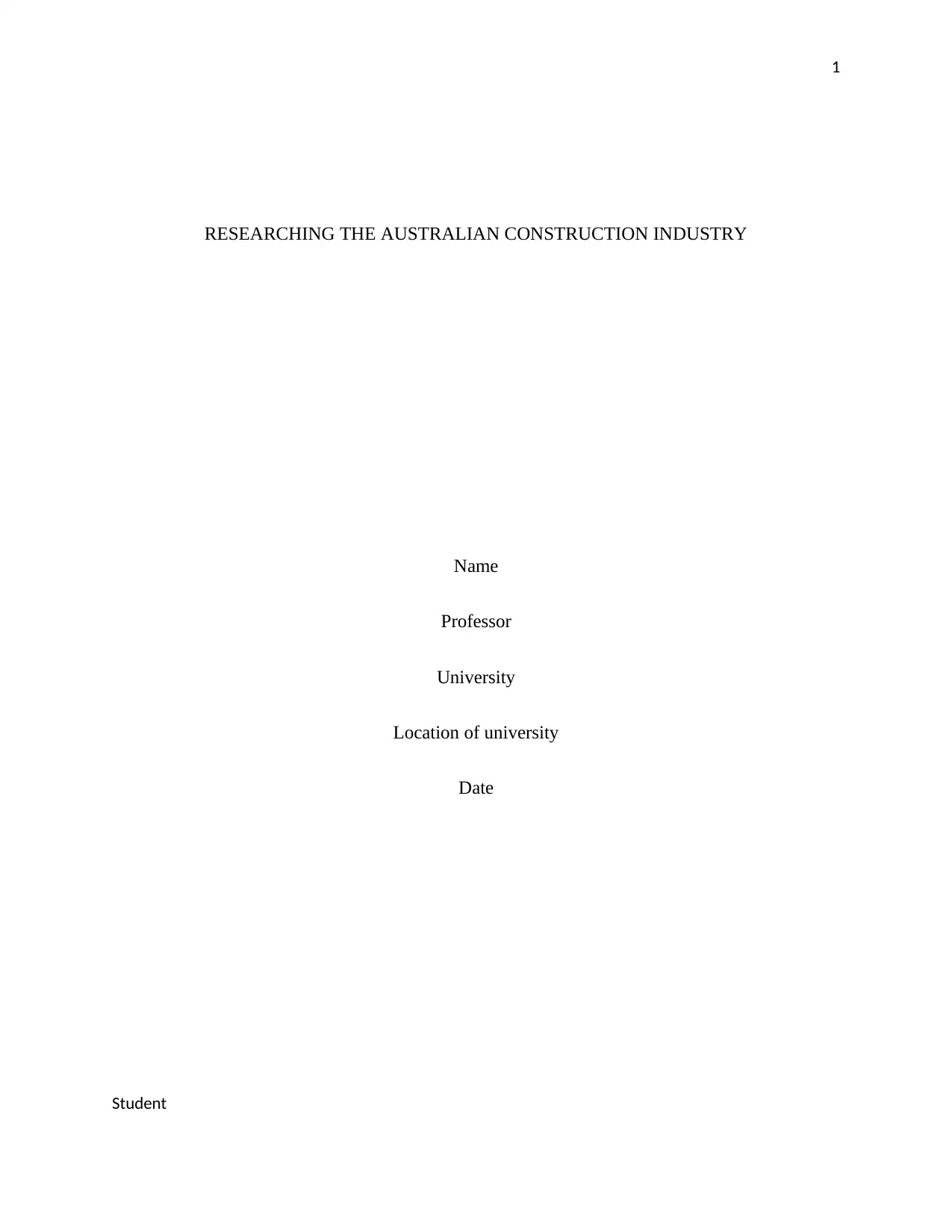
1
RESEARCHING THE AUSTRALIAN CONSTRUCTION INDUSTRY
Name
Professor
University
Location of university
Date
Student
RESEARCHING THE AUSTRALIAN CONSTRUCTION INDUSTRY
Name
Professor
University
Location of university
Date
Student
Paraphrase This Document
Need a fresh take? Get an instant paraphrase of this document with our AI Paraphraser
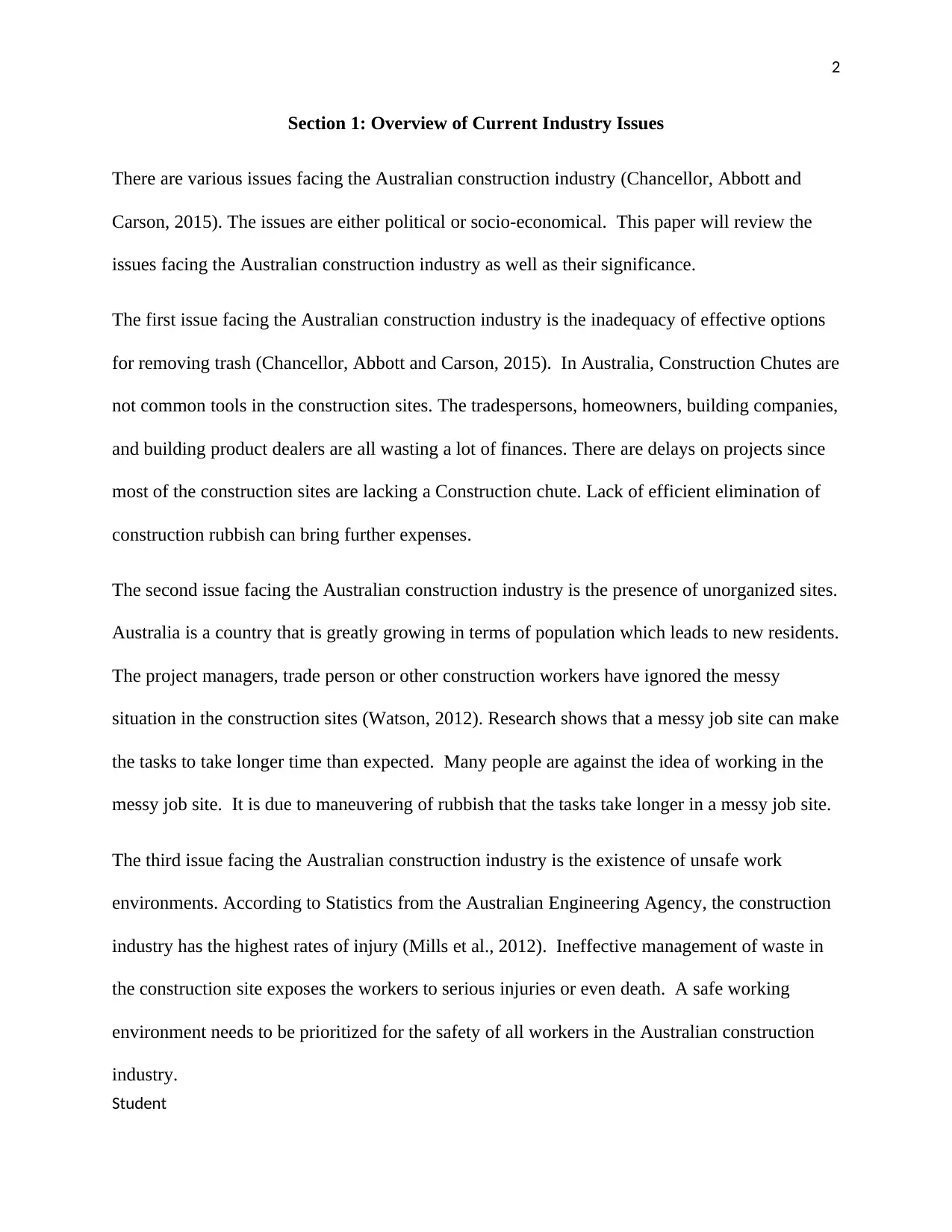
2
Section 1: Overview of Current Industry Issues
There are various issues facing the Australian construction industry (Chancellor, Abbott and
Carson, 2015). The issues are either political or socio-economical. This paper will review the
issues facing the Australian construction industry as well as their significance.
The first issue facing the Australian construction industry is the inadequacy of effective options
for removing trash (Chancellor, Abbott and Carson, 2015). In Australia, Construction Chutes are
not common tools in the construction sites. The tradespersons, homeowners, building companies,
and building product dealers are all wasting a lot of finances. There are delays on projects since
most of the construction sites are lacking a Construction chute. Lack of efficient elimination of
construction rubbish can bring further expenses.
The second issue facing the Australian construction industry is the presence of unorganized sites.
Australia is a country that is greatly growing in terms of population which leads to new residents.
The project managers, trade person or other construction workers have ignored the messy
situation in the construction sites (Watson, 2012). Research shows that a messy job site can make
the tasks to take longer time than expected. Many people are against the idea of working in the
messy job site. It is due to maneuvering of rubbish that the tasks take longer in a messy job site.
The third issue facing the Australian construction industry is the existence of unsafe work
environments. According to Statistics from the Australian Engineering Agency, the construction
industry has the highest rates of injury (Mills et al., 2012). Ineffective management of waste in
the construction site exposes the workers to serious injuries or even death. A safe working
environment needs to be prioritized for the safety of all workers in the Australian construction
industry.
Student
Section 1: Overview of Current Industry Issues
There are various issues facing the Australian construction industry (Chancellor, Abbott and
Carson, 2015). The issues are either political or socio-economical. This paper will review the
issues facing the Australian construction industry as well as their significance.
The first issue facing the Australian construction industry is the inadequacy of effective options
for removing trash (Chancellor, Abbott and Carson, 2015). In Australia, Construction Chutes are
not common tools in the construction sites. The tradespersons, homeowners, building companies,
and building product dealers are all wasting a lot of finances. There are delays on projects since
most of the construction sites are lacking a Construction chute. Lack of efficient elimination of
construction rubbish can bring further expenses.
The second issue facing the Australian construction industry is the presence of unorganized sites.
Australia is a country that is greatly growing in terms of population which leads to new residents.
The project managers, trade person or other construction workers have ignored the messy
situation in the construction sites (Watson, 2012). Research shows that a messy job site can make
the tasks to take longer time than expected. Many people are against the idea of working in the
messy job site. It is due to maneuvering of rubbish that the tasks take longer in a messy job site.
The third issue facing the Australian construction industry is the existence of unsafe work
environments. According to Statistics from the Australian Engineering Agency, the construction
industry has the highest rates of injury (Mills et al., 2012). Ineffective management of waste in
the construction site exposes the workers to serious injuries or even death. A safe working
environment needs to be prioritized for the safety of all workers in the Australian construction
industry.
Student
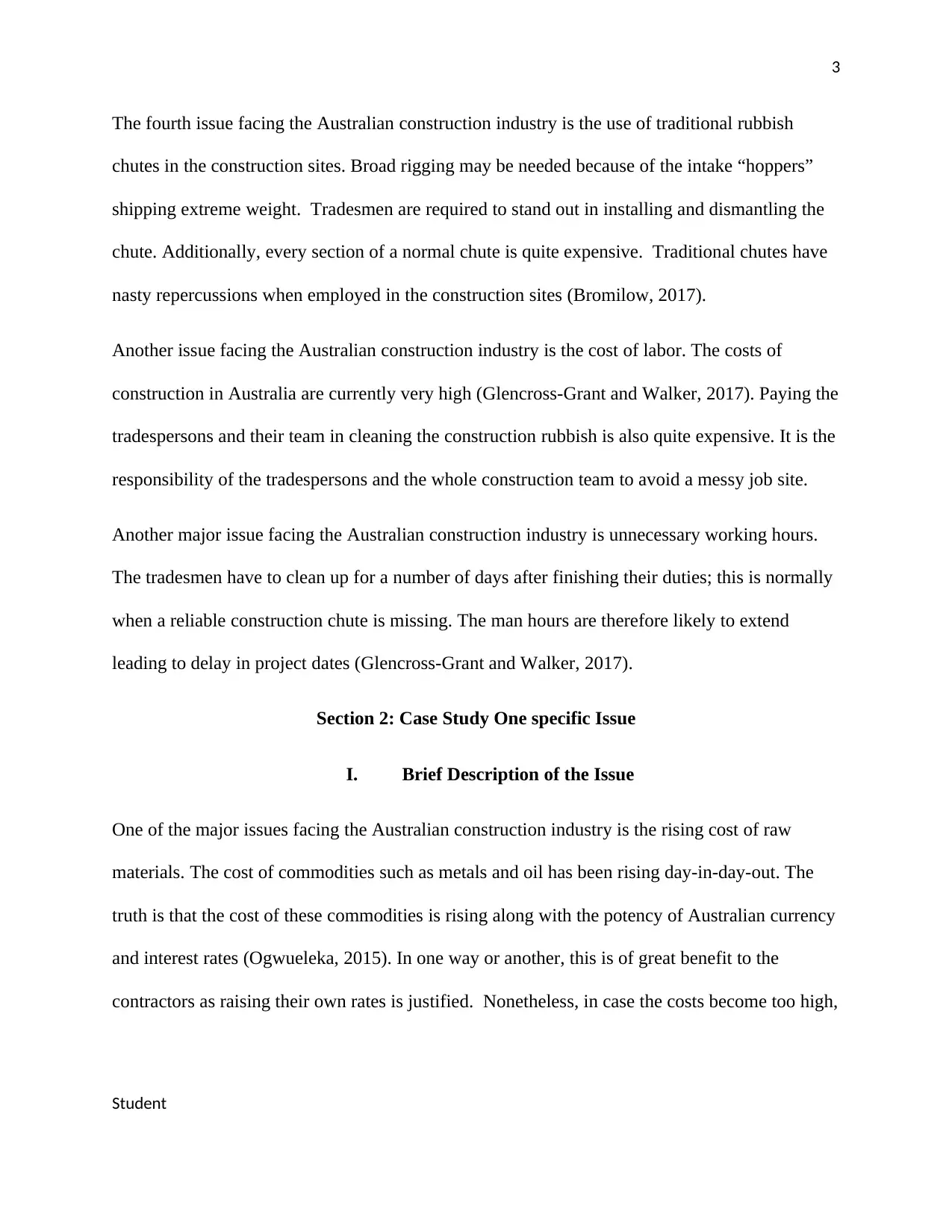
3
The fourth issue facing the Australian construction industry is the use of traditional rubbish
chutes in the construction sites. Broad rigging may be needed because of the intake “hoppers”
shipping extreme weight. Tradesmen are required to stand out in installing and dismantling the
chute. Additionally, every section of a normal chute is quite expensive. Traditional chutes have
nasty repercussions when employed in the construction sites (Bromilow, 2017).
Another issue facing the Australian construction industry is the cost of labor. The costs of
construction in Australia are currently very high (Glencross-Grant and Walker, 2017). Paying the
tradespersons and their team in cleaning the construction rubbish is also quite expensive. It is the
responsibility of the tradespersons and the whole construction team to avoid a messy job site.
Another major issue facing the Australian construction industry is unnecessary working hours.
The tradesmen have to clean up for a number of days after finishing their duties; this is normally
when a reliable construction chute is missing. The man hours are therefore likely to extend
leading to delay in project dates (Glencross-Grant and Walker, 2017).
Section 2: Case Study One specific Issue
I. Brief Description of the Issue
One of the major issues facing the Australian construction industry is the rising cost of raw
materials. The cost of commodities such as metals and oil has been rising day-in-day-out. The
truth is that the cost of these commodities is rising along with the potency of Australian currency
and interest rates (Ogwueleka, 2015). In one way or another, this is of great benefit to the
contractors as raising their own rates is justified. Nonetheless, in case the costs become too high,
Student
The fourth issue facing the Australian construction industry is the use of traditional rubbish
chutes in the construction sites. Broad rigging may be needed because of the intake “hoppers”
shipping extreme weight. Tradesmen are required to stand out in installing and dismantling the
chute. Additionally, every section of a normal chute is quite expensive. Traditional chutes have
nasty repercussions when employed in the construction sites (Bromilow, 2017).
Another issue facing the Australian construction industry is the cost of labor. The costs of
construction in Australia are currently very high (Glencross-Grant and Walker, 2017). Paying the
tradespersons and their team in cleaning the construction rubbish is also quite expensive. It is the
responsibility of the tradespersons and the whole construction team to avoid a messy job site.
Another major issue facing the Australian construction industry is unnecessary working hours.
The tradesmen have to clean up for a number of days after finishing their duties; this is normally
when a reliable construction chute is missing. The man hours are therefore likely to extend
leading to delay in project dates (Glencross-Grant and Walker, 2017).
Section 2: Case Study One specific Issue
I. Brief Description of the Issue
One of the major issues facing the Australian construction industry is the rising cost of raw
materials. The cost of commodities such as metals and oil has been rising day-in-day-out. The
truth is that the cost of these commodities is rising along with the potency of Australian currency
and interest rates (Ogwueleka, 2015). In one way or another, this is of great benefit to the
contractors as raising their own rates is justified. Nonetheless, in case the costs become too high,
Student
⊘ This is a preview!⊘
Do you want full access?
Subscribe today to unlock all pages.

Trusted by 1+ million students worldwide
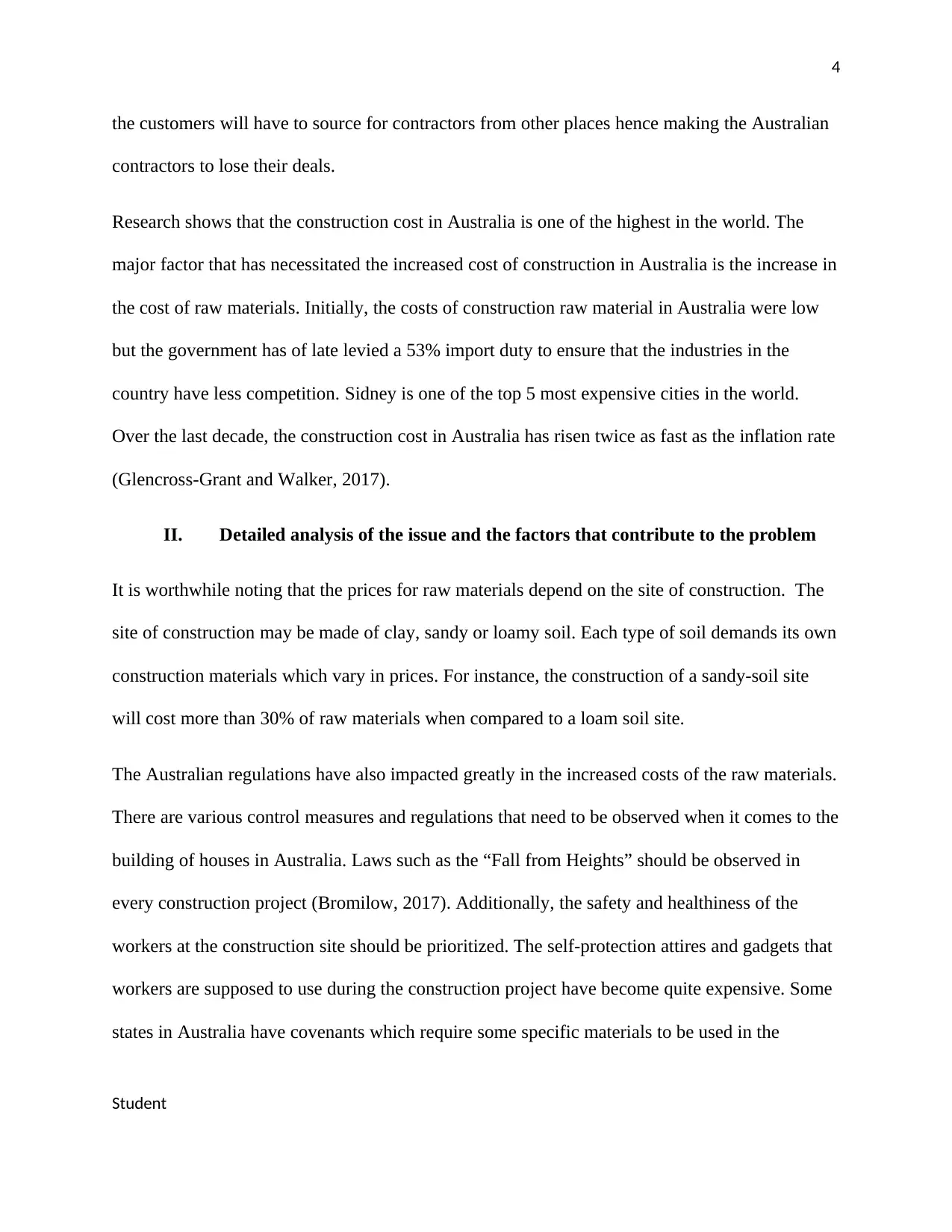
4
the customers will have to source for contractors from other places hence making the Australian
contractors to lose their deals.
Research shows that the construction cost in Australia is one of the highest in the world. The
major factor that has necessitated the increased cost of construction in Australia is the increase in
the cost of raw materials. Initially, the costs of construction raw material in Australia were low
but the government has of late levied a 53% import duty to ensure that the industries in the
country have less competition. Sidney is one of the top 5 most expensive cities in the world.
Over the last decade, the construction cost in Australia has risen twice as fast as the inflation rate
(Glencross-Grant and Walker, 2017).
II. Detailed analysis of the issue and the factors that contribute to the problem
It is worthwhile noting that the prices for raw materials depend on the site of construction. The
site of construction may be made of clay, sandy or loamy soil. Each type of soil demands its own
construction materials which vary in prices. For instance, the construction of a sandy-soil site
will cost more than 30% of raw materials when compared to a loam soil site.
The Australian regulations have also impacted greatly in the increased costs of the raw materials.
There are various control measures and regulations that need to be observed when it comes to the
building of houses in Australia. Laws such as the “Fall from Heights” should be observed in
every construction project (Bromilow, 2017). Additionally, the safety and healthiness of the
workers at the construction site should be prioritized. The self-protection attires and gadgets that
workers are supposed to use during the construction project have become quite expensive. Some
states in Australia have covenants which require some specific materials to be used in the
Student
the customers will have to source for contractors from other places hence making the Australian
contractors to lose their deals.
Research shows that the construction cost in Australia is one of the highest in the world. The
major factor that has necessitated the increased cost of construction in Australia is the increase in
the cost of raw materials. Initially, the costs of construction raw material in Australia were low
but the government has of late levied a 53% import duty to ensure that the industries in the
country have less competition. Sidney is one of the top 5 most expensive cities in the world.
Over the last decade, the construction cost in Australia has risen twice as fast as the inflation rate
(Glencross-Grant and Walker, 2017).
II. Detailed analysis of the issue and the factors that contribute to the problem
It is worthwhile noting that the prices for raw materials depend on the site of construction. The
site of construction may be made of clay, sandy or loamy soil. Each type of soil demands its own
construction materials which vary in prices. For instance, the construction of a sandy-soil site
will cost more than 30% of raw materials when compared to a loam soil site.
The Australian regulations have also impacted greatly in the increased costs of the raw materials.
There are various control measures and regulations that need to be observed when it comes to the
building of houses in Australia. Laws such as the “Fall from Heights” should be observed in
every construction project (Bromilow, 2017). Additionally, the safety and healthiness of the
workers at the construction site should be prioritized. The self-protection attires and gadgets that
workers are supposed to use during the construction project have become quite expensive. Some
states in Australia have covenants which require some specific materials to be used in the
Student
Paraphrase This Document
Need a fresh take? Get an instant paraphrase of this document with our AI Paraphraser
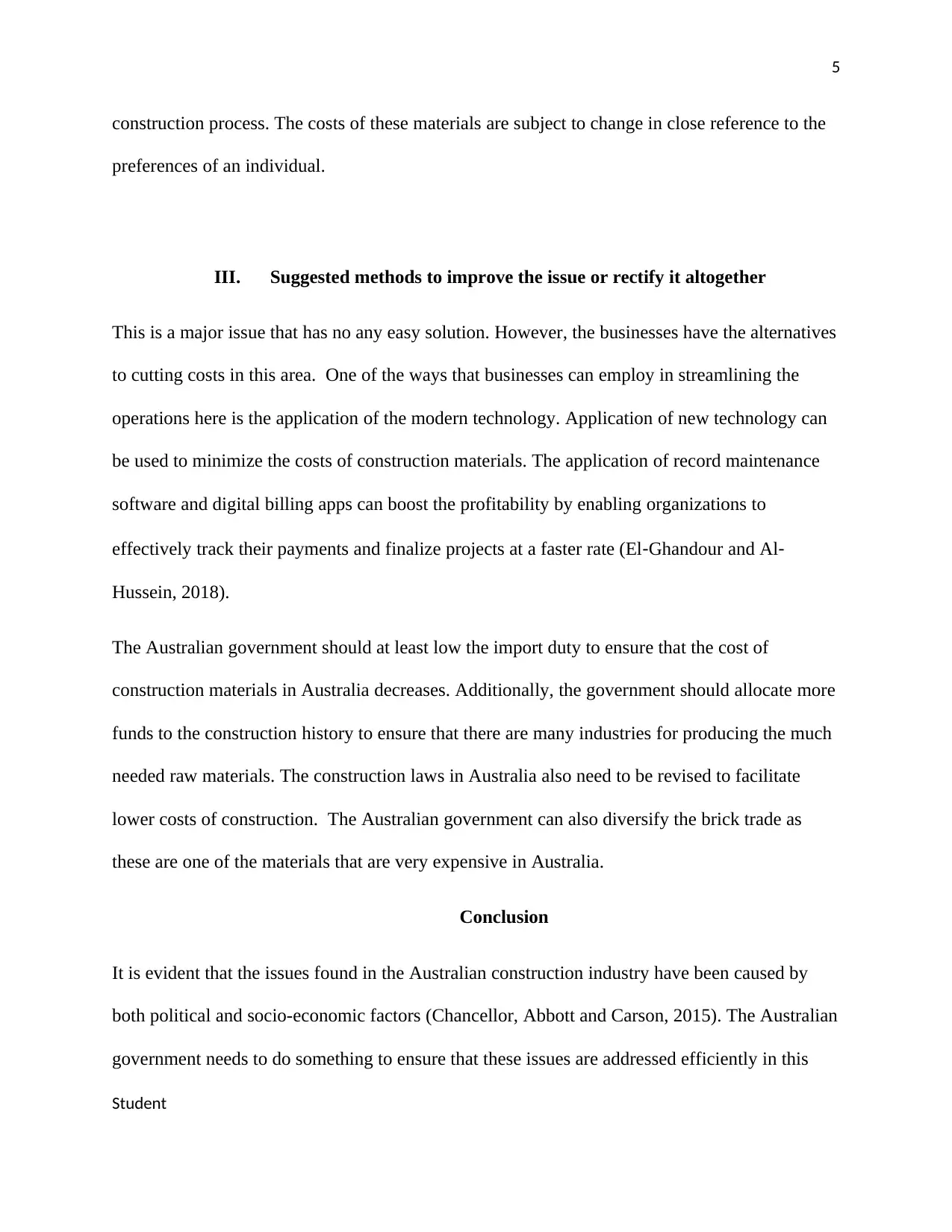
5
construction process. The costs of these materials are subject to change in close reference to the
preferences of an individual.
III. Suggested methods to improve the issue or rectify it altogether
This is a major issue that has no any easy solution. However, the businesses have the alternatives
to cutting costs in this area. One of the ways that businesses can employ in streamlining the
operations here is the application of the modern technology. Application of new technology can
be used to minimize the costs of construction materials. The application of record maintenance
software and digital billing apps can boost the profitability by enabling organizations to
effectively track their payments and finalize projects at a faster rate (El‐Ghandour and Al‐
Hussein, 2018).
The Australian government should at least low the import duty to ensure that the cost of
construction materials in Australia decreases. Additionally, the government should allocate more
funds to the construction history to ensure that there are many industries for producing the much
needed raw materials. The construction laws in Australia also need to be revised to facilitate
lower costs of construction. The Australian government can also diversify the brick trade as
these are one of the materials that are very expensive in Australia.
Conclusion
It is evident that the issues found in the Australian construction industry have been caused by
both political and socio-economic factors (Chancellor, Abbott and Carson, 2015). The Australian
government needs to do something to ensure that these issues are addressed efficiently in this
Student
construction process. The costs of these materials are subject to change in close reference to the
preferences of an individual.
III. Suggested methods to improve the issue or rectify it altogether
This is a major issue that has no any easy solution. However, the businesses have the alternatives
to cutting costs in this area. One of the ways that businesses can employ in streamlining the
operations here is the application of the modern technology. Application of new technology can
be used to minimize the costs of construction materials. The application of record maintenance
software and digital billing apps can boost the profitability by enabling organizations to
effectively track their payments and finalize projects at a faster rate (El‐Ghandour and Al‐
Hussein, 2018).
The Australian government should at least low the import duty to ensure that the cost of
construction materials in Australia decreases. Additionally, the government should allocate more
funds to the construction history to ensure that there are many industries for producing the much
needed raw materials. The construction laws in Australia also need to be revised to facilitate
lower costs of construction. The Australian government can also diversify the brick trade as
these are one of the materials that are very expensive in Australia.
Conclusion
It is evident that the issues found in the Australian construction industry have been caused by
both political and socio-economic factors (Chancellor, Abbott and Carson, 2015). The Australian
government needs to do something to ensure that these issues are addressed efficiently in this
Student
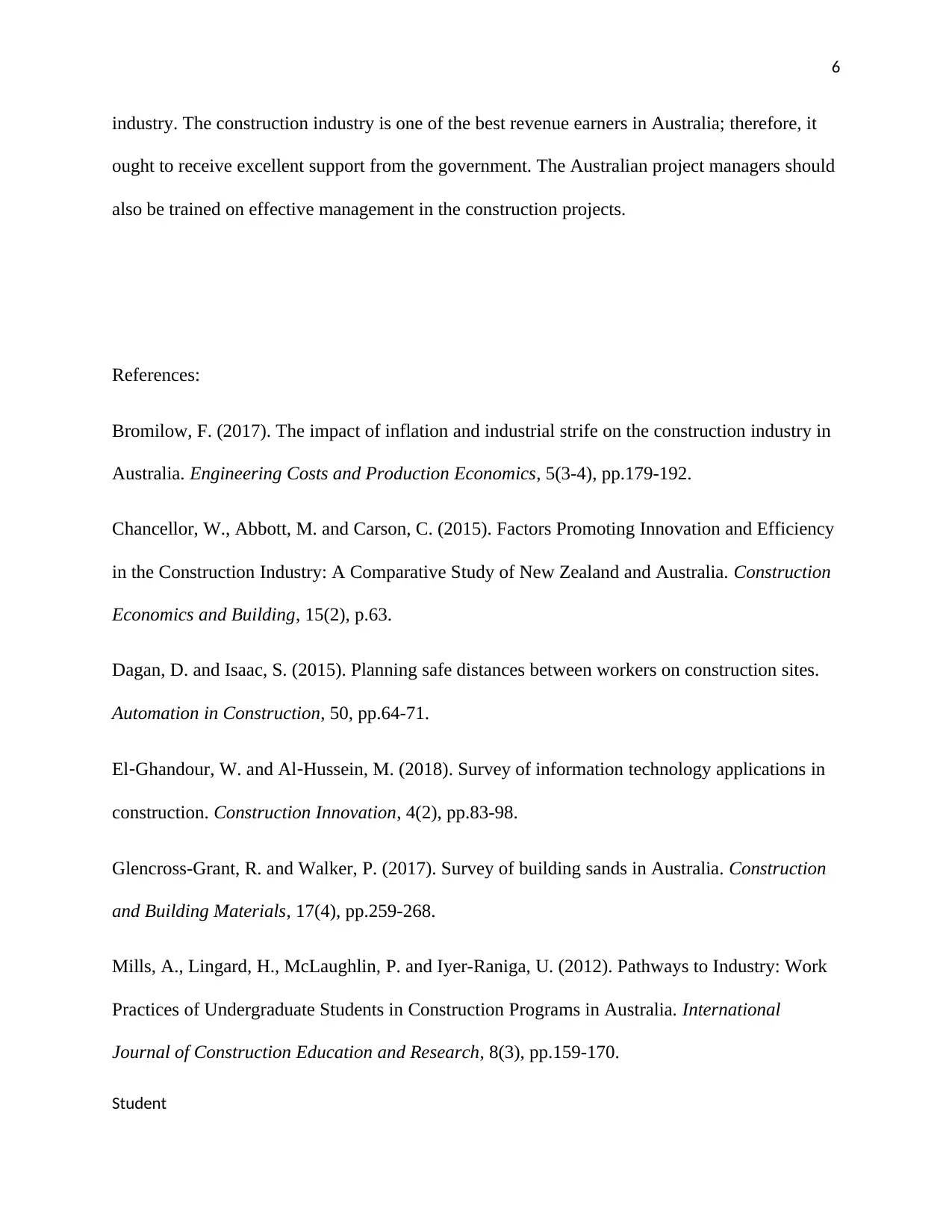
6
industry. The construction industry is one of the best revenue earners in Australia; therefore, it
ought to receive excellent support from the government. The Australian project managers should
also be trained on effective management in the construction projects.
References:
Bromilow, F. (2017). The impact of inflation and industrial strife on the construction industry in
Australia. Engineering Costs and Production Economics, 5(3-4), pp.179-192.
Chancellor, W., Abbott, M. and Carson, C. (2015). Factors Promoting Innovation and Efficiency
in the Construction Industry: A Comparative Study of New Zealand and Australia. Construction
Economics and Building, 15(2), p.63.
Dagan, D. and Isaac, S. (2015). Planning safe distances between workers on construction sites.
Automation in Construction, 50, pp.64-71.
El‐Ghandour, W. and Al‐Hussein, M. (2018). Survey of information technology applications in
construction. Construction Innovation, 4(2), pp.83-98.
Glencross-Grant, R. and Walker, P. (2017). Survey of building sands in Australia. Construction
and Building Materials, 17(4), pp.259-268.
Mills, A., Lingard, H., McLaughlin, P. and Iyer-Raniga, U. (2012). Pathways to Industry: Work
Practices of Undergraduate Students in Construction Programs in Australia. International
Journal of Construction Education and Research, 8(3), pp.159-170.
Student
industry. The construction industry is one of the best revenue earners in Australia; therefore, it
ought to receive excellent support from the government. The Australian project managers should
also be trained on effective management in the construction projects.
References:
Bromilow, F. (2017). The impact of inflation and industrial strife on the construction industry in
Australia. Engineering Costs and Production Economics, 5(3-4), pp.179-192.
Chancellor, W., Abbott, M. and Carson, C. (2015). Factors Promoting Innovation and Efficiency
in the Construction Industry: A Comparative Study of New Zealand and Australia. Construction
Economics and Building, 15(2), p.63.
Dagan, D. and Isaac, S. (2015). Planning safe distances between workers on construction sites.
Automation in Construction, 50, pp.64-71.
El‐Ghandour, W. and Al‐Hussein, M. (2018). Survey of information technology applications in
construction. Construction Innovation, 4(2), pp.83-98.
Glencross-Grant, R. and Walker, P. (2017). Survey of building sands in Australia. Construction
and Building Materials, 17(4), pp.259-268.
Mills, A., Lingard, H., McLaughlin, P. and Iyer-Raniga, U. (2012). Pathways to Industry: Work
Practices of Undergraduate Students in Construction Programs in Australia. International
Journal of Construction Education and Research, 8(3), pp.159-170.
Student
⊘ This is a preview!⊘
Do you want full access?
Subscribe today to unlock all pages.

Trusted by 1+ million students worldwide
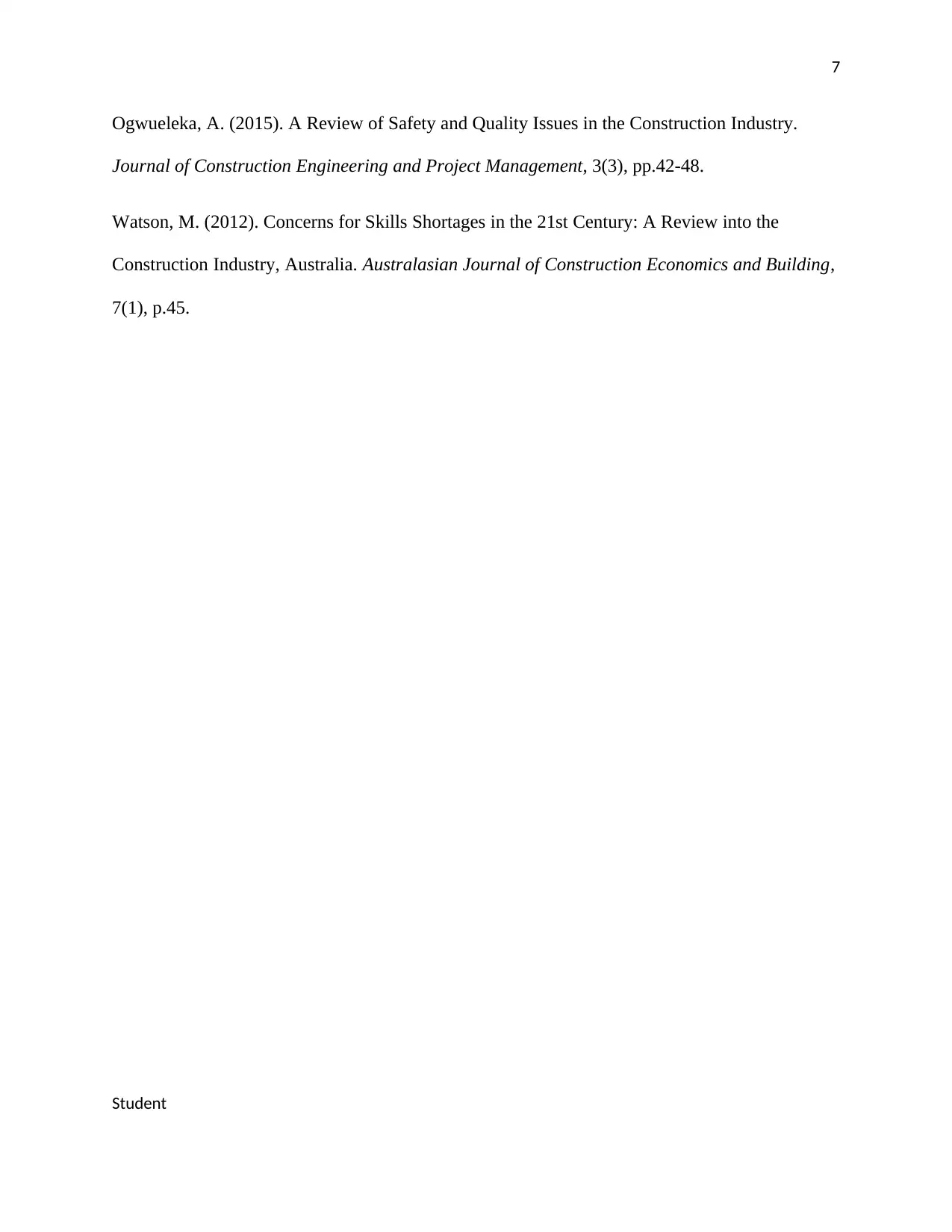
7
Ogwueleka, A. (2015). A Review of Safety and Quality Issues in the Construction Industry.
Journal of Construction Engineering and Project Management, 3(3), pp.42-48.
Watson, M. (2012). Concerns for Skills Shortages in the 21st Century: A Review into the
Construction Industry, Australia. Australasian Journal of Construction Economics and Building,
7(1), p.45.
Student
Ogwueleka, A. (2015). A Review of Safety and Quality Issues in the Construction Industry.
Journal of Construction Engineering and Project Management, 3(3), pp.42-48.
Watson, M. (2012). Concerns for Skills Shortages in the 21st Century: A Review into the
Construction Industry, Australia. Australasian Journal of Construction Economics and Building,
7(1), p.45.
Student
1 out of 7
Your All-in-One AI-Powered Toolkit for Academic Success.
+13062052269
info@desklib.com
Available 24*7 on WhatsApp / Email
![[object Object]](/_next/static/media/star-bottom.7253800d.svg)
Unlock your academic potential
Copyright © 2020–2025 A2Z Services. All Rights Reserved. Developed and managed by ZUCOL.